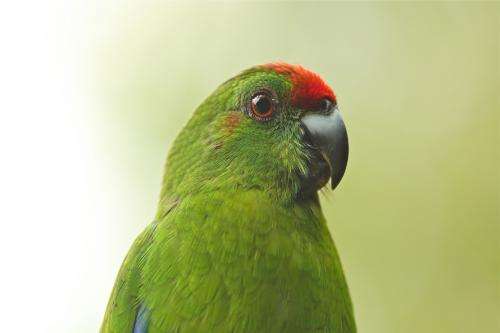Norfolk Island's endangered Green Parrot numbers on the rise

The population of the critically endangered Green Parrot (Cyanoramphus cookii) on Norfolk Island is on the rise, thanks to an intensive collaboration between Massey University researchers and Norfolk Island National Park (NINP) ecologists and rangers.
Dr Luis Ortiz-Catedral, ecology researcher and lecturer at the Institute of Natural and Mathematical Sciences at Massey University, arrived on Norfolk Island a year ago to assist with the implementation of an action plan to try and bolster Green Parrot numbers. Dr Ortiz-Catedral has previously had success helping increase the populations of other threatened species in New Zealand, including the red-fronted parakeet and orange-fronted parakeet.
"We know over the last 30 years the population of Norfolk Island Green Parrots has gradually declined, mostly due to the limited number of suitable nesting sites, competition for nests and predation by cats and rats. But before we could work out a plan to arrest the decline we needed to find out exactly how many birds were left in the park," Dr Ortiz-Catedral says.
"In July 2013 it was estimated that there were between 46 and 93 individual birds remaining, from an estimated population of 240 birds in 2010. There was also a gender skew, with fewer adult females than males. There were only 10 confirmed records of adult females, with a maximum number of 23 breeding pairs. Although the Green Parrot breeds all year round, there is a notable increase in breeding in the late summer/early autumn season.
"Part of the problem was habitat. The Green Parrot prefers to use nesting hollows in native trees. Predation by cats and rats, and competition for nesting hollows by introduced bird species and bees meant the Green Parrot was easy prey and could be eaten or displaced from its habitat.
Armed with this up-to-date information, Natural Resource Manager for Norfolk Island National Park, Abigail Smith, developed an action plan for the recovery of the Norfolk Island Green Parrot.
"We knew that the best way to help the Green Parrot was to implement an improved assisted breeding programme that would deal with the introduced crimson rosellas, starlings and rats that interfere with incubating females," Ms Smith says.
"Once hatched, chicks have roughly a 65 per cent chance of surviving to fledging, thus the key modification to the assisted breeding programme was minimising disturbance to females while nesting," Dr Ortiz-Catedral says.
The first step in the action plan was establishing as many predator-proof nesting sites as possible. Over a six-month period 75 nesting sites were constructed and monitored by Norfolk Island National Park staff once a month for signs of nesting activity. Active nests were monitored twice a week, and any chicks found were weighed and measured to ensure they were thriving. Active sites were also monitored using motion-sensor cameras to record activity and detect any interference from other species. In addition, an extensive search of old and degraded nest sites, and research into potential new sites to be constructed, were fed into the project database of safe nesting sites.
The second step, implemented simultaneously, was to improve the effectiveness of cat and rat control on the island, and, in collaboration with the Norfolk Island Government, also initiate a control programme for feral birds across the island.
Since 1996, Norfolk Island National Park had implemented a cat-trapping programme, with varying degrees of success. Thirty baited cat traps were placed strategically within the park, and set twice a week. This current cat-trapping programme is under review and a cat management plan is being prepared.
A rat-baiting programme has also been implemented, with 800 bait stations checked each month, and all known, functional nest sites further surrounded by three bait stations and three break-back traps set. Rat activity throughout the park is monitored regularly and a review of rat bait is also underway.
One year after the start of the action plan commenced, the results have been astounding. There are now 78 predator-resistant nest sites for the Green Parrot, with 11 active nests.
"This winter 51 chicks have fledged, of which 25 are female. This is a significant step towards balancing the observed sex skew in the population. This is by far the most productive winter breeding for the species in record," Ms Smith says.
Ms Smith and Dr Ortiz-Catedral are delighted with the results so far, but say they still have a lot of work to do.
"The results so far have been spectacular, and that is thanks to so many people working together to make this possible. But we still need funding to keep the momentum going, and to really make a difference to conserving the Green Parrot species for generations to come," Ms Smith says.
"I believe the key to the success of this project has been the close collaboration between managers and rangers on the ground and scientists visiting Norfolk Island. Together we have developed local capacity to establish a solid foundation for the recovery of one of the world's rarest birds. The work done on the ground by all the staff from Norfolk Island National Park is nothing short of extraordinary," Dr Ortiz-Catedral says.
Provided by Massey University
















